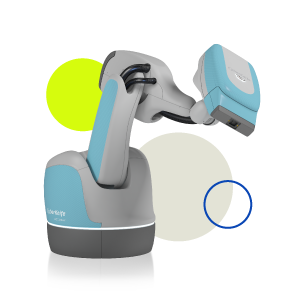Realizing the promise of hypofractionation
One of the advanced treatment modalities that is moving into the mainstream is hypofractionated radiotherapy — delivering a high dose per fraction across fewer total treatment sessions. A growing body of clinical evidence supports hypofractionation as a proven treatment modality, delivering clinical outcomes comparable and in some cases superior to those from conventionally fractionated treatments while dramatically reducing the number of treatment fractions (dramatically lowering the total cost of care) and giving patients and their support systems the benefit of fewer clinic visits and a faster return to everyday life. Hypofractionation can reduce treatment times by approximately 91-93% for lung cancer[1], 87% for prostate cancer[2], and 67% for breast cancer[3], compared to conventional fractionation treatment times.
It would seem that hypofractionation delivers a win-win for patients and providers. Yet hypofractionation has historically fought against reimbursement challenges that have limited its use. The conventional fee-for-service (FFS) model in the United States has the unintended impact of disincentivizing the shorter treatment courses of hypofractionated radiotherapy. Or, at the very least, the current FFS model does not do enough to incentivize clinics’ investments in the technologies needed to deliver hypofractionated radiotherapy. In other words, under the current FFS system, older, less-precise technology — requiring weeks of low-dose radiation — is rewarded over high-technology systems that can achieve equivalent to superior outcomes following 1-5 treatment sessions.
Value-based care changing the calculus on hypofractionation
Value-based healthcare is a delivery framework that incentivizes healthcare providers to focus on the quality of services, as opposed to quantity[4]. This means healthcare providers (including hospitals and physicians) are compensated based on patient health outcomes. Value-based healthcare programs are vital to reform how healthcare is delivered and paid for. Payments do not vary based on the modality used or the fractionation scheme selected for treatment of an indication. In effect, this means that conventional fractionation is reimbursed at the same fixed rate as treatment modalities that involve the delivery of fewer fractions, including hypofractionated radiotherapy.
But it’s not just that hypofractionation will be reimbursed at an equal level to traditional fractionation — the clinical and economic efficiencies of hypofractionation will ultimately make the more sophisticated treatment also a more profitable one. A 2020 study by the American Society of Clinical Oncology found great cost-saving promise for hypofractionation radiotherapy around the world. It found the cost of conventional versus hypofractionated treatment for breast cancer was $2,232 and $1,339 respectively—a cost reduction of nearly half. For prostate treatment, the costs were $3,389 and $1,699 respectively—an equally impressive cost reduction[5].
The basic math of the value-based reimbursement equation means that, for many cancer types, conventional fractionation schedules will effectively see deep reimbursement cuts. Put another way, under the value-based care model, the cost to deliver additional fractions is owned by the provider — not passed along to the payer and/or patient.
Hypofractionation set to become mainstream treatment modality
This shift completely changes the economic calculus around advanced treatments like hypofractionated radiotherapy. The field is already seeing surging investment in radiotherapy delivery technologies built to enable hypo- and ultra-fractionated treatments, as more practices believe that hypofractionation will soon become mainstream as conventional fractionation grows less economically viable. But this eager adoption of hypofractionation is not merely positioning for future success. Forward-thinking radiotherapy clinics are showcasing their hypofractionated treatment capabilities and expertise as a critical differentiator in the increasingly competitive, consumerized healthcare market. Today’s highly informed, empowered patients-as-consumers are seeking out more effective, less disruptive treatment options like hypofractionation. And whether they’re insured or paying out of pocket, they all have a keener eye toward the increasingly transparent costs of care — readily understanding that the efficiencies delivered by hypofractionation benefit the patient, the provider and the greater public.
Adaptive radiotherapy (ART) following a similar trajectory
Another promising, innovative treatment protocol being pushed toward the mainstream by value-based care is adaptive radiotherapy (ART). ART has always been a theoretical ideal — carefully adapting treatment plans to account for tumor/target shifts and changes, as well as anatomical changes. But, like hypofractionation, it has conventionally struggled with limited practicality. Conventional ART is resource-intensive, which translates to cost-intensive — and that higher cost has not always been met with higher reimbursement under the fee-for-service model.
Today, ART technologies are approaching a threshold that, like hypofractionation, will change the economic calculus around ART. The next frontier in ART is artificial intelligence (AI)-supported treatment planning. Leveraging the incredible computing power of modern AI and machine learning algorithms, innovators are beginning to solve the challenge of determining if, when and how to adapt treatment plans. The AI-supported technologies will automatically analyze daily images, flagging cases for clinician review — so clinical teams can focus their time and attention on cases where the clinical benefits merit plan adaptation. AI-supported auto-contouring and auto-segmentation capabilities will make plan adaptation itself significantly more efficient, reducing the clinical resource burden and ultimately making ART more economically viable.
The shift toward value-based care will accelerate that move into the mainstream, propelling more clinics to implement leading-edge, AI-supported technologies that enable modern, efficient ART. Following the trajectory of hypofractionation, value-based reimbursement models will connect the proven clinical benefits of ART with higher levels of reimbursement. Furthermore, adoption of ART will enable clinics to align with the consumerized healthcare landscape — where patients are today demanding highly personalized treatment that ART delivers.
Value-based care will incentivize advanced treatment
We’re confident that the shift toward value-based reimbursement models will undoubtedly inspire — and require — practices to make investments in advanced treatment technologies. It will incentivize the implementation of a new breed of workhorse treatment delivery system. Radiotherapy clinics will need modern treatment delivery systems capable of providing advanced capabilities like hypofractionation, real-time ART and AI-supported treatment planning — with the versatility and flexibility to treat all indications, anywhere in the body, and accommodate a high patient volume necessary to meet surging demand and economic pressures.
How should radiotherapy clinics be preparing for the future of value-based reimbursement?
Read the Accuray eBook for a closer look at what value-based care means for patients, providers and the future of radiotherapy — and the key capabilities RT clinics should be focusing on enabling to position for success tomorrow.
References
- Jeppesen SS, Schytte T, Jensen HR, Brink C, Hansen O. Stereotactic body radiation therapy versus conventional radiation therapy in patients with early stage non-small cell lung cancer: an updated retrospective study on local failure and survival rates. Acta Oncol. 2013 Oct;52(7):1552-8. doi: 10.3109/0284186X.2013.813635. Epub 2013 Aug 1. PMID: 23902274.
- Tree AC, Ostler P, van der Voet H, Chu W, Loblaw A, Ford D, Tolan S, Jain S, Martin A, Staffurth J, Armstrong J, Camilleri P, Kancherla K, Frew J, Chan A, Dayes IS, Duffton A, Brand DH, Henderson D, Morrison K, Brown S, Pugh J, Burnett S, Mahmud M, Hinder V, Naismith O, Hall E, van As N; PACE Trial Investigators. Intensity-modulated radiotherapy versus stereotactic body radiotherapy for prostate cancer (PACE-B): 2-year toxicity results from an open-label, randomised, phase 3, non-inferiority trial. Lancet Oncol. 2022 Oct;23(10):1308-1320. doi: 10.1016/S1470-2045(22)00517-4. Epub 2022 Sep 13. PMID: 36113498
- Murray Brunt A, Haviland JS, Wheatley DA, Sydenham MA, Alhasso A, Bloomfield DJ, Chan C, Churn M, Cleator S, Coles CE, Goodman A, Harnett A, Hopwood P, Kirby AM, Kirwan CC, Morris C, Nabi Z, Sawyer E, Somaiah N, Stones L, Syndikus I, Bliss JM, Yarnold JR; FAST-Forward Trial Management Group. Hypofractionated breast radiotherapy for 1 week versus 3 weeks (FAST-Forward): 5-year efficacy and late normal tissue effects results from a multicentre, non-inferiority, randomised, phase 3 trial. Lancet. 2020 May 23;395(10237):1613-1626. doi: 10.1016/S0140-6736(20)30932-6. Epub 2020 Apr 28. PMID: 32580883; PMCID: PMC7262592.
- What is Value-Based Healthcare? A Complete Guide | Veradigm
- Omoruyi Credit Irabor, William Swanson, Fiza Shaukat, Johanna Wirtz, Abba Aji Mallum, Twalib Ngoma, Ahmed Elzawawy, Paul Nguyen, Luca Incrocci, and Wilfred Ngwa. ‘Can the Adoption of Hypofractionation Guidelines Expand Global Radiotherapy Access? An Analysis for Breast and Prostate Radiotherapy’. JCO Global Oncology 2020 :6, 667-678








